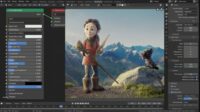
3D Modeling Software Comparison: Finding the Perfect Fit
Introduction
In the realm of 3D design, selecting the right software can make all the difference. With a plethora of options available, it can be daunting to navigate the landscape and find the perfect fit for your specific needs. This article aims to provide an in-depth comparison of leading 3D modeling software, highlighting their strengths, limitations, and suitability for various applications.
Key Considerations
- Purpose: Define the primary purpose for which you need the software, whether it’s product design, architectural modeling, animation, or video game development.
- Skill Level: Consider your current skill level and the learning curve associated with each software. Some programs are more beginner-friendly, while others require advanced technical knowledge.
- Industry Standard: Determine if your industry has a preferred software or if you need software that is compatible with industry-standard file formats.
- Cost: Software costs can range from free to thousands of dollars. Establish a budget and explore the pricing models (e.g., subscription, perpetual license) of different software.
Top 3D Modeling Software
1. Blender
- Free and Open-Source: Blender is a widely popular software available for free under the GNU GPL license.
- Comprehensive Suite: It offers a wide range of features, including modeling, rigging, animation, rendering, compositing, and video editing.
- Python Scripting: Blender supports Python scripting, allowing users to automate tasks and create custom tools.
- Strong Community: Blender boasts a large and active user community that provides support, resources, and add-ons.
- Limitations: The interface can be complex for beginners, and certain features may not be as robust as dedicated commercial software.
2. Autodesk Maya
- Industry Standard: Maya is a widely used industry-standard software, particularly in film, animation, and game development.
- Powerful Toolset: It offers a comprehensive toolset for modeling, animation, rigging, rendering, and dynamics simulation.
- Node-Based Workflow: Maya uses a node-based workflow, providing flexibility and control over complex workflows.
- High Learning Curve: Maya has a steep learning curve and requires a significant investment of time and effort to master.
- Cost: Maya is a commercial software with a subscription or perpetual license model, making it a more expensive option.
3. Autodesk 3ds Max
- Versatile: 3ds Max is a versatile software suitable for various industries, including architecture, product design, and game development.
- UI Customization: It allows for extensive UI customization, enabling users to tailor the interface to their workflow preferences.
- Powerful Modeling Tools: 3ds Max has a robust set of modeling tools, making it ideal for creating complex and intricate models.
- Limited Animation: While it offers basic animation capabilities, 3ds Max is primarily used for modeling and rendering.
- Cost: 3ds Max is a commercial software with a subscription or perpetual license model, similar to Maya.
4. SketchUp
- Beginner-Friendly: SketchUp is designed to be intuitive and easy to learn, making it a suitable option for beginners and hobbyists.
- Architectural Focus: It is primarily used for architectural modeling and interior design due to its streamlined workflow and integration with design tools.
- Limited Toolset: SketchUp has a more limited toolset compared to other professional software, which may not be sufficient for advanced modeling tasks.
- Free and Paid Versions: SketchUp Free is a basic version with limited features, while SketchUp Pro offers a more comprehensive toolset.
- Cost: SketchUp Pro has a subscription-based pricing model.
5. SolidWorks
- CAD Software: SolidWorks is a computer-aided design (CAD) software primarily used for mechanical engineering and product development.
- Precise Modeling: It offers precise and parametric modeling capabilities, allowing users to create accurate and detailed designs.
- Simulation and Analysis: SolidWorks includes powerful simulation and analysis tools for testing and validating designs.
- Not Ideal for Organic Forms: SolidWorks is less suited for modeling organic or free-form shapes, which may require additional software.
- Cost: SolidWorks is a commercial software with a subscription or perpetual license model.
Choosing the Right Software
For Beginners:
- Blender
- SketchUp
- Onshape (Free online CAD software)
For Architectural Modeling:
- SketchUp
- Revit
- Archicad
For Product Design:
- SolidWorks
- Fusion 360
- Catia
For Animation and Game Development:
- Autodesk Maya
- Autodesk 3ds Max
- Blender
- Cinema 4D
For Organic Modeling:
- ZBrush
- Maya
- Blender
FAQ
Q: How do I choose the best software for my needs?
A: Consider your purpose, skill level, industry standard, and budget when evaluating different software.
Q: Can I use free software for professional work?
A: Yes, Blender is a free and open-source software that can be used for professional-grade work, but it may require additional effort to achieve the same level of polish as commercial software.
Q: Is it better to purchase a subscription or perpetual license?
A: Subscription models provide access to the latest software updates and support, while perpetual licenses offer a one-time purchase with ongoing maintenance costs.
Q: What is the learning curve like for different software?
A: Blender and SketchUp have a relatively low learning curve, while Maya and 3ds Max require more time and effort to master.
References
- Autodesk Maya: https://www.autodesk.com/products/maya/overview
- Autodesk 3ds Max: https://www.autodesk.com/products/3ds-max/overview
- Blender: https://www.blender.org/
- SketchUp: https://www.sketchup.com/
- SolidWorks: https://www.solidworks.com/
- Onshape: https://www.onshape.com/


